Prediction and Multiparametric Optimization of the Machined Surface Quality of Tool Steels in Precise Wire Electrical Discharge Machining
Abstract
:1. Introduction
2. Materials and Methods
2.1. Material and Technological Equipment Used in the Performed Experimental Research
2.2. Analysis of Aspects of Multiparametric Optimization of the Output Parameters MRR and SR of the Electrical Discharge Process
3. Results and Discussion
3.1. Design of Experimental Plan Using the DoE Method
3.2. Analysis of the Output Parameters SR and MRR during Electroerosion of Tool Steels Using the GRA Method
3.3. Analysis of the Recorded Values of the Input and Output Parameters of the Electroerosion Process Using the ANOVA Method with Regard to GRG
3.4. Proposal of MRM for the Prediction of SR and MRR Output Parameters during WEDM of Tool Steels
3.5. Optimization of the Quality Parameter SR of the Machined Surface with Regard to the Maximization of MRR Productivity during WEDM of Tool Steels
4. Conclusions
Author Contributions
Funding
Data Availability Statement
Acknowledgments
Conflicts of Interest
Nomenclature
| ANOVA | Analysis of Variance |
| ANN | Artificial Neural Network |
| DoE | Design of Experiments |
| GA | Genetic Algorithm |
| GRA | Grey Relational Analysis |
| GRC | Grey Relation Coefficient |
| GRG | Grey Relational Grade |
| HB | Higher is Better |
| HV | High Value |
| LV | Lower Value |
| MRM | Multiple Regression Models |
| MRR | Material Removal Rate |
| MS | Mean Square |
| MSD | Mean Square Deviation |
| NTM | Non-Traditional Machining |
| SB | Smaller is Better |
| SR | Surface Roughness |
| TV | Target Value |
| TWR | Tool Wear Rate |
| WEDM | Wire Electrical Discharge Machining |
| I | Peak Current (A) |
| ton | Pulse On-time Duration (µs) |
| toff | Pulse Off-time Duration (µs) |
| U | Voltage of Discharge (V) |
| R2 | Determination Coefficient |
| Sequence After Data Preprocessing, | |
| Original Sequence | |
| Largest Value of | |
| Simply the Smallest Value of |
References
- Aggarwal, V.; Khangura, S.S.; Garg, R.K. Parametric modeling and optimization for wire electrical discharge machining of Inconel 718 using response surface methodology. Int. J. Adv. Manuf. Technol. 2015, 79, 31–47. [Google Scholar] [CrossRef]
- Dzionk, S.; Siemiatkowski, M.S. Studying the effect of working conditions on WEDM machining performance of super alloy Inconel 617. Machines 2020, 8, 54. [Google Scholar] [CrossRef]
- Dodun, O.; Slătineanu, L.; Nagîț, G.; Hrițuc, A.; Mihalache, A.M.; Beșliu-Băncescu, I. WEDM-generated slot width variation modelling. Micromachines 2022, 13, 1231. [Google Scholar] [CrossRef]
- Nowicki, R.; Świercz, R.; Oniszczuk-Świercz, D.; Rozenek, M. Experimental investigation of technological indicators and surface roughness of hastelloy C-22 after electrical discharge machining using POCO graphite electrodes. Materials 2022, 15, 5631. [Google Scholar] [CrossRef]
- Mičietová, A.; Neslušan, M.; Čilliková, M. Influence of surface geometry and structure after non-conventional methods of parting on the following milling operations. Manuf. Technol. 2013, 13, 199–204. [Google Scholar] [CrossRef]
- Fassi, I.; Modica, F. Editorial for the special issue on micro-electro discharge machining: Principles, Recent advancements and applications, volume II. Micromachines 2023, 14, 29. [Google Scholar] [CrossRef]
- Gorgani, H.H.; Jahazi, A.; Pak, A.J.; Shabani, S. A hybrid algorithm for adjusting the input parameters of the wirecut EDM machine in order to obtain maximum customer satisfaction. SN Appl. Sci. 2023, 5, 37. [Google Scholar] [CrossRef]
- Grigoriev, S.N.; Kozochkin, M.P.; Gurin, V.D.; Malakhinsky, A.P.; Porvatov, A.N.; Melnik, Y.A. Display of WEDM quality indicators of heat-resistant alloy processing in acoustic emission parameters. Sensors 2023, 23, 8288. [Google Scholar] [CrossRef]
- Wang, J.; Sanchez, J.A.; Izquierdo, B.; Ayesta, I. Experimental and numerical study of crater volume in wire electrical discharge machining. Materials 2020, 13, 577. [Google Scholar] [CrossRef]
- Evin, E.; Tomáš, M.; Kmec, J. Optimization of electro-discharge texturing parameters for steel sheets’ finishing rollers. Materials 2020, 13, 1223. [Google Scholar] [CrossRef]
- Kiyak, M. Investigation of effects of cutting parameters on surface quality and hardness in the wire-EDM process. Int. J. Adv. Manuf. Technol. 2021, 119, 647–655. [Google Scholar] [CrossRef]
- Mouralova, K.; Zahradnicek, R.; Houska, P. Evaluation of surface quality of X210Cr12 steel for forming tools machined by WEDM. MM Sci. J. 2016, 5, 1366–1369. [Google Scholar] [CrossRef]
- Kosaraju, S.; Bobba, B.P.; Salkuti, S.R. Optimization and microstructural studies on the machining of Inconel 600 in WEDM using untreated and cryogenically treated zinc electrodes. Materials 2023, 16, 3181. [Google Scholar] [CrossRef]
- Straka, L.; Dittrich, G. Influence of tool steel properties on surface quality after electrical discharge machining by wire electrode. Int. J. Adv. Manuf. Technol. 2020, 106, 1617–1632. [Google Scholar] [CrossRef]
- Kumar, M.; Singh, H. Multi response optimization in wire electrical discharge machining of Inconel X-750 using Taguchi’s technique and grey relational analysis. Cogent Eng. 2016, 3, 1266123. [Google Scholar] [CrossRef]
- Singh, B.; Misra, J.P. Empirical Modelling of Wear Ratio during WEDM of Nimonic 263. Mater. Today Proc. 2018, 5, 23612–23618. [Google Scholar] [CrossRef]
- Vikasa, A.K.R.; Kumarb, K. Effect and optimization of various machine process parameters on the MRR, over-cut and surface roughness in EDM for an EN41 material using grey-taguchi approach. Int. J. Appl. Eng. Res. 2014, 9, 8963–8966. [Google Scholar]
- Sharma, S.; Vates, U.K.; Bansal, A. Parametric optimization in wire EDM of D2 tool steel using Taguchi method. Mater. Today Proc. 2021, 45, 757–763. [Google Scholar] [CrossRef]
- Huang, J.T.; Liao, Y.S. Optimization of machining parameters of Wire-EDM based on Grey relational and statistical analyses. Int. J. Prod. Res. 2003, 41, 1707–1720. [Google Scholar] [CrossRef]
- Kumar, A.; Jagota, V.; Shawl, R.Q.; Sharma, V.; Sargam, K.; Shabaz, M.; Tanveer Khan, M.; Rabani, B.; Gandhi, S. Wire EDM process parameter optimization for D2 steel. Mater. Today Proc. 2021, 37, 2478–2482. [Google Scholar] [CrossRef]
- Zhu, S.; Chen, W.; Zhan, X.; Ding, L.; Zhou, J. Parameter optimisation of laser cladding repair for an Invar alloy mould. Proc. Inst. Mech. Eng. Part B J. Eng. Manuf. 2019, 233, 1859–1871. [Google Scholar] [CrossRef]
- Pradhan, B.B.; Masanta, M.; Sarkar, B.R.; Bhattacharyya, B. Investigation of electro-discharge micro-machining of titanium super alloy. Int. J. Adv. Manuf. Technol. 2009, 41, 1094–1106. [Google Scholar] [CrossRef]
- Somashekhar, K.P.; Ramachandran, N.; Mathew, J. Optimization of material removal rate in micro-EDM using artificial neural network and genetic algorithms. Mater. Manuf. Process. 2010, 25, 467–475. [Google Scholar] [CrossRef]
- Meena, V.K.; Azad, M.S. Grey relational analysis of micro-EDM machining of Ti-6Al-4V alloy. Mater. Manuf. Process. 2012, 27, 973–977. [Google Scholar] [CrossRef]
- Kopytowski, A.; Świercz, R.; Oniszczuk-Świercz, D.; Zawora, J.; Kuczak, J.; Żrodowski, Ł. Effects of a New Type of Grinding Wheel with Multi-Granular Abrasive Grains on Surface Topography Properties after Grinding of Inconel 625. Materials 2023, 16, 716. [Google Scholar] [CrossRef]
- Mouralova, K.; Bednar, J.; Benes, L.; Prokes, T.; Zahradnicek, R.; Fries, J. Mathematical models for machining optimization of Ampcoloy 35 with different thicknesses using WEDM to improve the surface properties of mold parts. Materials 2023, 16, 100. [Google Scholar] [CrossRef]
- Ming, W.; Guo, X.; Zhang, G.; Hu, S.; Liu, Z.; Xie, Z.; Zhang, S.; Duan, L. Optimization of process parameters and performance for machining Inconel 718 in renewable dielectrics. Alex. Eng. J. 2023, 79, 164–179. [Google Scholar] [CrossRef]
- Pi, V.N.; Tam, D.T.; Cuong, N.M.; Tran, T.H. Multi-objective optimization of PMEDM process parameters for processing cylindrical shaped parts using taguchi method and grey relational analysis. Int. J. Mech. Prod. Eng. Res. Dev. 2020, 10, 669–678. [Google Scholar]
- Zhu, Z.; Guo, D.; Xu, J.; Lin, J.; Lei, J.; Xu, B.; Wu, X.; Wang, X. Processing Characteristics of Micro Electrical Discharge Machining for Surface Modification of TiNi Shape Memory Alloys Using a TiC Powder Dielectric. Micromachines 2020, 11, 1018. [Google Scholar] [CrossRef]
- Meshram, D.B.; Puri, Y.M. Optimized curved electrical discharge machining-based curvature channel. J. Braz. Soc. Mech. Sci. 2020, 42, 82. [Google Scholar] [CrossRef]
- Rafaqat, M.; Mufti, N.A.; Ahmed, N.; Rehman, A.U.; AlFaify, A.Y.; Farooq, M.U.; Saleh, M. Hole-making in D2-Grade steel tool by electric-discharge machining through non-conventional electrodes. Processes 2022, 10, 1553. [Google Scholar] [CrossRef]
- Selvarajan, L.; Venkataramanan, K. Si3N4–TiN conductive ceramic composites: Topography on EDMed surfaces and precise drilled holes. Mater. Sci. Technol. 2023, 39, 2006–2017. [Google Scholar] [CrossRef]
- Panda, A.; Anisimov, V.M.; Anisimov, V.V.; Diadiura, K.O.; Pandova, I.V.E.T.A. Increasing of wear resistance of linear block-polyurethanes by thermal processing methods. MM Sci. J. 2021, 10, 731–4735. [Google Scholar] [CrossRef]
- Seshaiah, S.; Sampathkumar, D.; Mariappan, M.; Mohankumar, A.; Balachandran, G.; Kaliyamoorthy, M.; Rajendran, B.; Gopal, R. Advanced Materials for Promoting. Sustainability 2022, 2022, 6022550. [Google Scholar]
- Jagadish; Ray, A. Multi-objective optimization of green EDM: An integrated theory. J. Inst. Eng. Ser. C 2015, 96, 41–47. [Google Scholar] [CrossRef]
- Padhi, P.C.; Mahapatra, S.S.; Yadav, S.N.; Tripathy, D.K. Multi-objective optimization of wire electrical discharge machining (WEDM) process parameters using weighted sum genetic algorithm approach. J. Adv. Manuf. Syst. 2016, 15, 85–100. [Google Scholar] [CrossRef]
- Abhishek, T.; Mandal, A.; Kumar, K. Multi-objective optimization of electro-chemical machining by non-dominated sorting genetic algorithm. Mater. Today Proc. 2015, 2, 2569–2575. [Google Scholar]
- Kalita, K.; Chakraborty, S.; Ghadai, R.K.; Chakraborty, S. Parametric optimization of non-traditional machining processes using multi-criteria decision making techniques: Literature review and future directions. Multiscale Multidiscip. Model. Exp. Des. 2023, 6, 1–40. [Google Scholar] [CrossRef]
- Shankar, C.; Chatterjee, P.; Protim, D.P. A DoE–TOPSIS method-based meta-model for parametric optimization of non-traditional machining processes. J. Model. Manag. 2019, 14, 430–455. [Google Scholar]
- Ganesh, N.; Ghadai, R.K.; Bhoi, A.K.; Kalita, K.; Gao, X.Z. An intelligent predictive model-based multi-response optimization of EDM process. Comput. Model. Eng. Sci. 2020, 124, 459–476. [Google Scholar] [CrossRef]
- Chakraborty, S. Multi-objective optimization of EDM process on AISI P-20 Tool steel using multi-criteria decision-making technique. In Machine Learning Applications in Non-Conventional Machining Processes; IGI Global: Hershey, PA, USA, 2021; pp. 33–44. [Google Scholar]
- Ram Prasad, A.V.S.; Ramji, K.; Kolli, M.; Krishna, G.V. Multi-response optimization of machining process parameters for wire electrical discharge machining of lead-induced Ti-6Al-4V alloy using AHP–TOPSIS method. J. Adv. Manuf. Sys. 2019, 18, 213–236. [Google Scholar] [CrossRef]
- Mouralova, K.; Benes, L.; Zahradnicek, R.; Bednar, J.; Zadera, A.; Fries, J.; Kana, V. WEDM Used for machining high entropy alloys. Materials 2020, 13, 4823. [Google Scholar] [CrossRef]
- Singh, D.P.; Mishra, S. Effect of different reinforcements in wire electric discharge machining of various geometrical profiles in metal matrix composites. Int. J. Interact. Des. Manuf. 2023, 18, 351–373. [Google Scholar] [CrossRef]
- Straka, L.; Pitel, J.; Corny, I. Influence of the main technological parameters and material properties of the workpiece on the geometrical accuracy of the machined surface at WEDM. Int. J. Adv. Manuf. Technol. 2021, 115, 3065–3087. [Google Scholar] [CrossRef]
- Singh, V.; Sharma, A.K.; Goyal, A.; Saxena, K.K.; Negi, P.; Rao, P.C.S. Electric discharge machining performance measures and optimisation: A review. Adv. Mater. Process. Technol. 2023, 1–14. [Google Scholar] [CrossRef]
- Świercz, R.; Oniszczuk-Świercz, D.; Zawora, J.; Marczak, M. Investigation of the Influence of Process Parameters on Shape Deviation after Wire Electrical Discharge Machining. Arch. Metall. Mater. 2019, 64, 1457–1462. [Google Scholar] [CrossRef]
- Takale, A.M.; Chougule, N.K.; Selmokar, P.H.; Gawari, M.G. Multi-response optimization of micro-WEDM process parameters of Ti49.4-Ni50.6 shape memory alloy for orthopedic implant application. Adv. Mater. Res. 2018, 1150, 1–21. [Google Scholar] [CrossRef]
- Sahu, N.K.; Singh, M.K.; Sahu, A.K.; Sahu, A.K. Multi Parametric Investigation for Improvement in Machining Characteristics on Aluminium Boron Carbide Composite in WEDM. In Springer Proceedings in Materials; Springer: Singapore, 2023; Volume 26, pp. 81–93. [Google Scholar]
- Choudhary, P.; Desale, Y.B.; Ranjan, G.; Naik, B.K.; Singh, V.K. Parametric optimization of wire EDM process for single crystal pure tungsten using Taguchi-Grey relational analysis. Sādhanā 2023, 48, 152. [Google Scholar] [CrossRef]
- Wang, S.M.; Wu, J.X.; Gunawan, H.; Tu, R.Q. Optimization of Machining Parameters for Corner Accuracy Improvement for WEDM Processing. Appl. Sci. 2022, 12, 10324. [Google Scholar] [CrossRef]
- Yu, T.; Zhao, J. Quantifying the mechanisms of keyhole pore evolutions and the role of metal-vapor condensation in laser powder bed fusion. Addit. Manuf. 2023, 72, 103642. [Google Scholar] [CrossRef]
- Rimár, M.; Abraham, M.; Fedák, M.; Kulikov, A.; Oravec, P.; Váhovský, J. Methods of increasing the efficiency of cogeneration based energy equipment. MM Sci. J. 2019, 6, 2935–2938. [Google Scholar] [CrossRef]
- Van, D.N.; Van, B.P.; Huu, P.N. Application of Deng’s similarity-based analytic hierarchy process approach in parametric optimization of the electrical discharge machining process of SDK11 die steel. Trans. Can. Soc. Mech. Eng. 2020, 44, 294–310. [Google Scholar] [CrossRef]
- Rani, S.S.; Sundari, V.K.; Jose, P.S.H.; Sivaranjani, S.; Stalin, B.; Pritima, D. Enrichment of material subtraction rate on Eglin steel using electrical discharge machining process through modification of electrical circuits. Mater. Today 2020, 33, 4428–4430. [Google Scholar] [CrossRef]
- Świercz, R.; Oniszczuk-Świercz, D. Experimental Investigation of Surface Layer Properties of High Thermal Conductivity Tool Steel after Electrical Discharge Machining. Metals 2017, 7, 550. [Google Scholar] [CrossRef]
- Oniszczuk-Świercz, D.; Świercz, R.; Michna, Š. Evaluation of prediction models of the microwire EDM process of Inconel 718 using ANN and RSM methods. Materials 2022, 15, 8317. [Google Scholar] [CrossRef]
- Mouralova, K.; Benes, L.; Prokes, T.; Zahradnicek, R.; Fries, J.; Plichta, T. Analysis of the machinability of different types of sintered carbides with WEDM in both water and oil baths. Int. J. Adv. Manuf. Technol. 2023, 125, 2705–2715. [Google Scholar] [CrossRef]
- Židek, K.; Piteľ, J.; Adámek, M.; Lazorík, P.; Hošovský, A. Digital Twin of Experimental Smart Manufacturing Assembly System for Industry 4.0 Concept. Sustainability 2020, 12, 3658. [Google Scholar] [CrossRef]
- Hašová, S.; Straka, Ľ. Design and verification of software for simulation of selected quality indicators of machined surface after WEDM. Acad. J. Manuf. Eng. 2016, 14, 13–20. [Google Scholar]
- Straka, Ľ.; Čorný, I.; Piteľ, J.; Hašová, S. Statistical Approach to Optimize the Process Parameters of HAZ of Tool Steel EN X32CrMoV12-28 after Die-Sinking EDM with SF-Cu Electrode. Metals 2017, 7, 35. [Google Scholar] [CrossRef]
- Vagaská, A.; Gombár, M.; Straka, Ľ. Selected mathematical optimization methods for solving problems of engineering practice. Energies 2022, 15, 2205. [Google Scholar]
- Rouniyar, A.K.; Shandilya, P. Fabrication and experimental investigation of magnetic field assisted powder mixed electrical discharge machining on machining of aluminum 6061 alloy. Proc. Inst. Mech. Eng. Part B J. Eng. Manuf. 2019, 233, 2283–2291. [Google Scholar] [CrossRef]
- Wang, G.; Han, F.A. Comparative study on the surface integrity of single-step and multi-step sequential machining in electric discharge machining. Int. J. Adv. Manuf. Technol. 2021, 114, 1803–1817. [Google Scholar] [CrossRef]
- Oniszczuk-Swiercz, D.; Swiercz, R.; Chmielewski, T.; Salacinski, T. Experimental investigation of influence WEDM parameters on surface roughness and flatness deviation. Metal 2020, 29, 611–617. [Google Scholar]
- Grigoriev, S.N.; Pivkin, P.M.; Kozochkin, M.P.; Volosova, M.A.; Okunkova, A.A.; Porvatov, A.N.; Zelensky, A.A.; Nadykto, A.B. Physicomechanical nature of acoustic emission preceding wire breakage during wire electrical discharge machining (WEDM) of advanced cutting tool materials. Metals 2021, 11, 1865. [Google Scholar] [CrossRef]
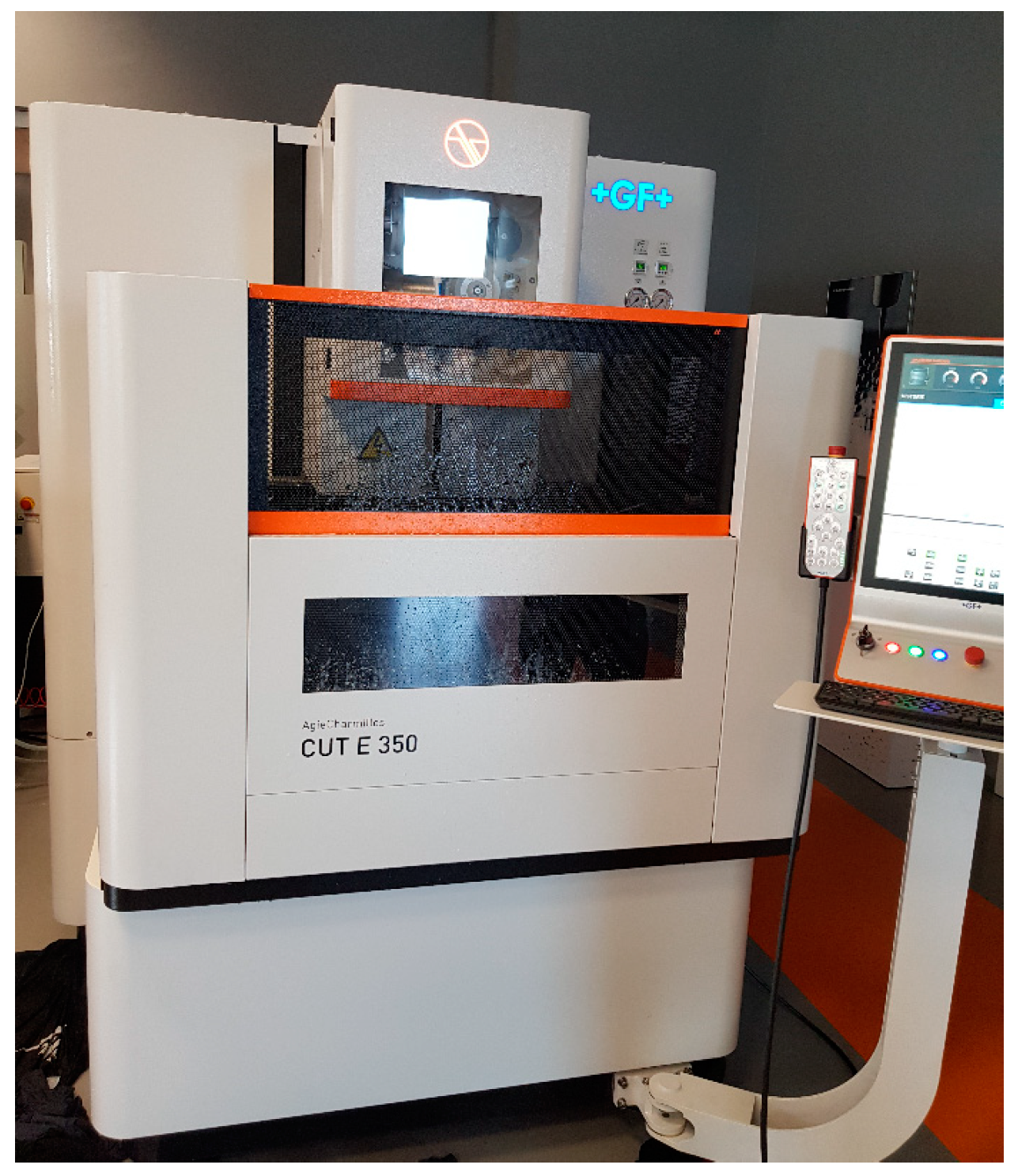
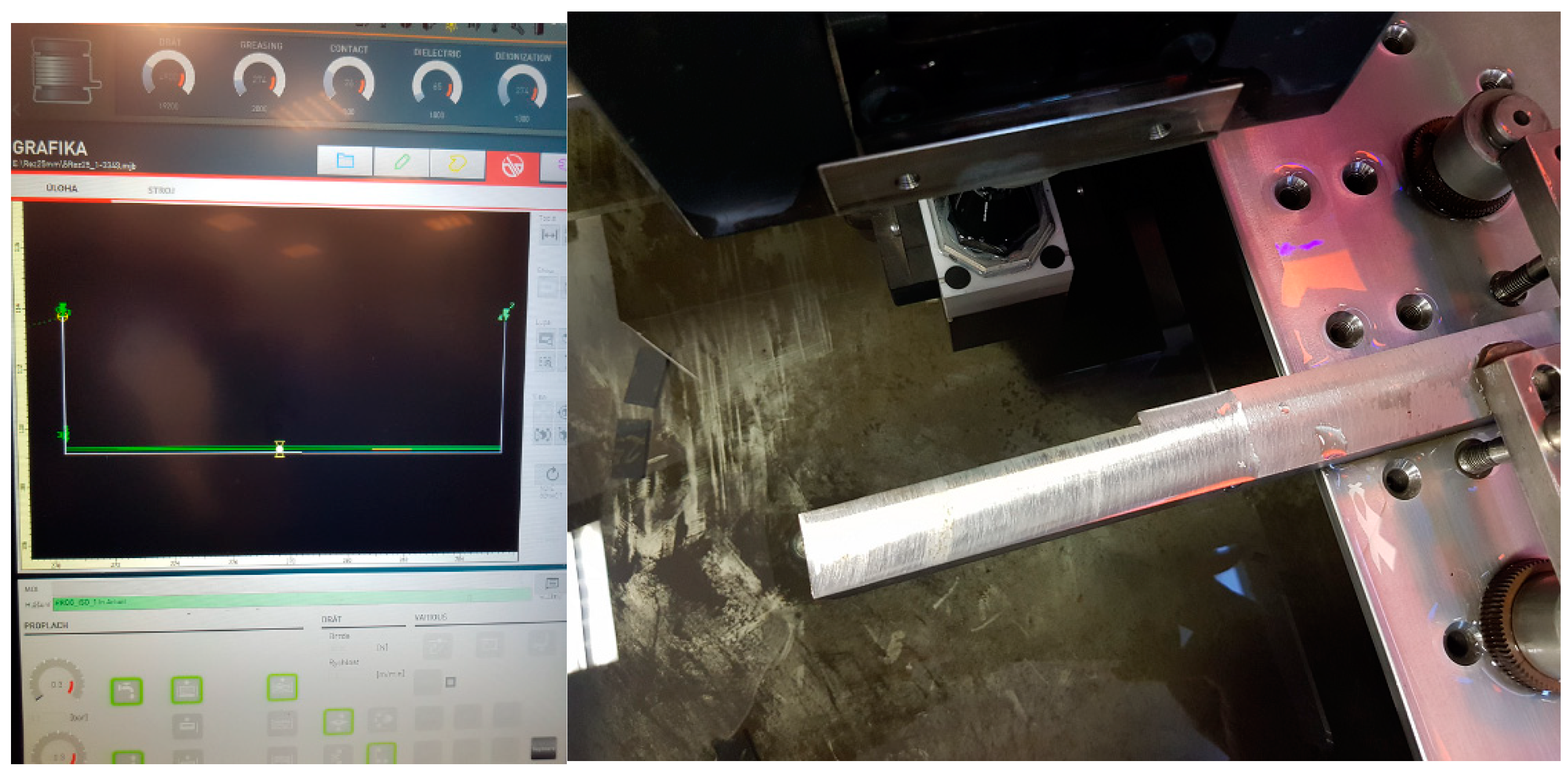

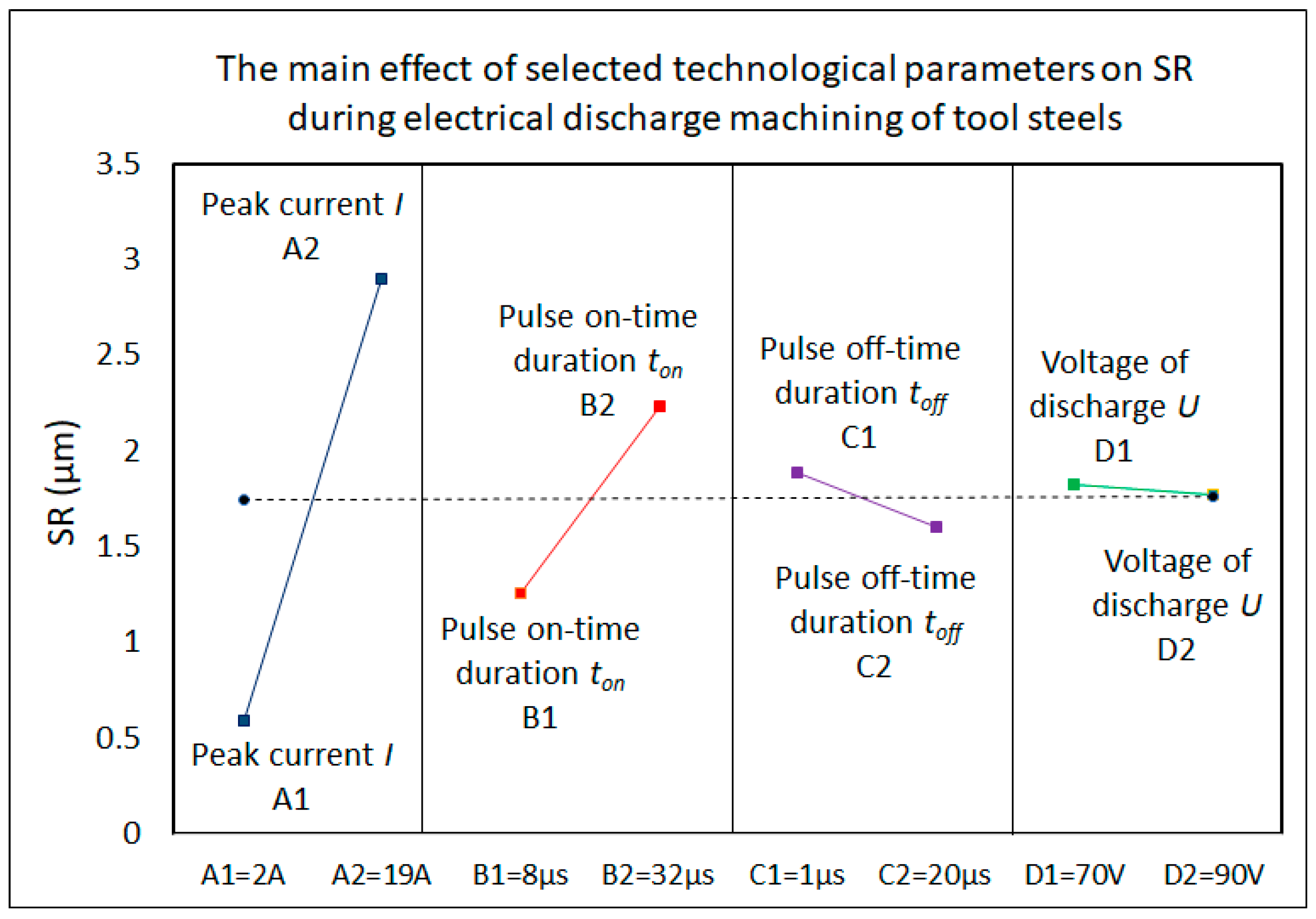




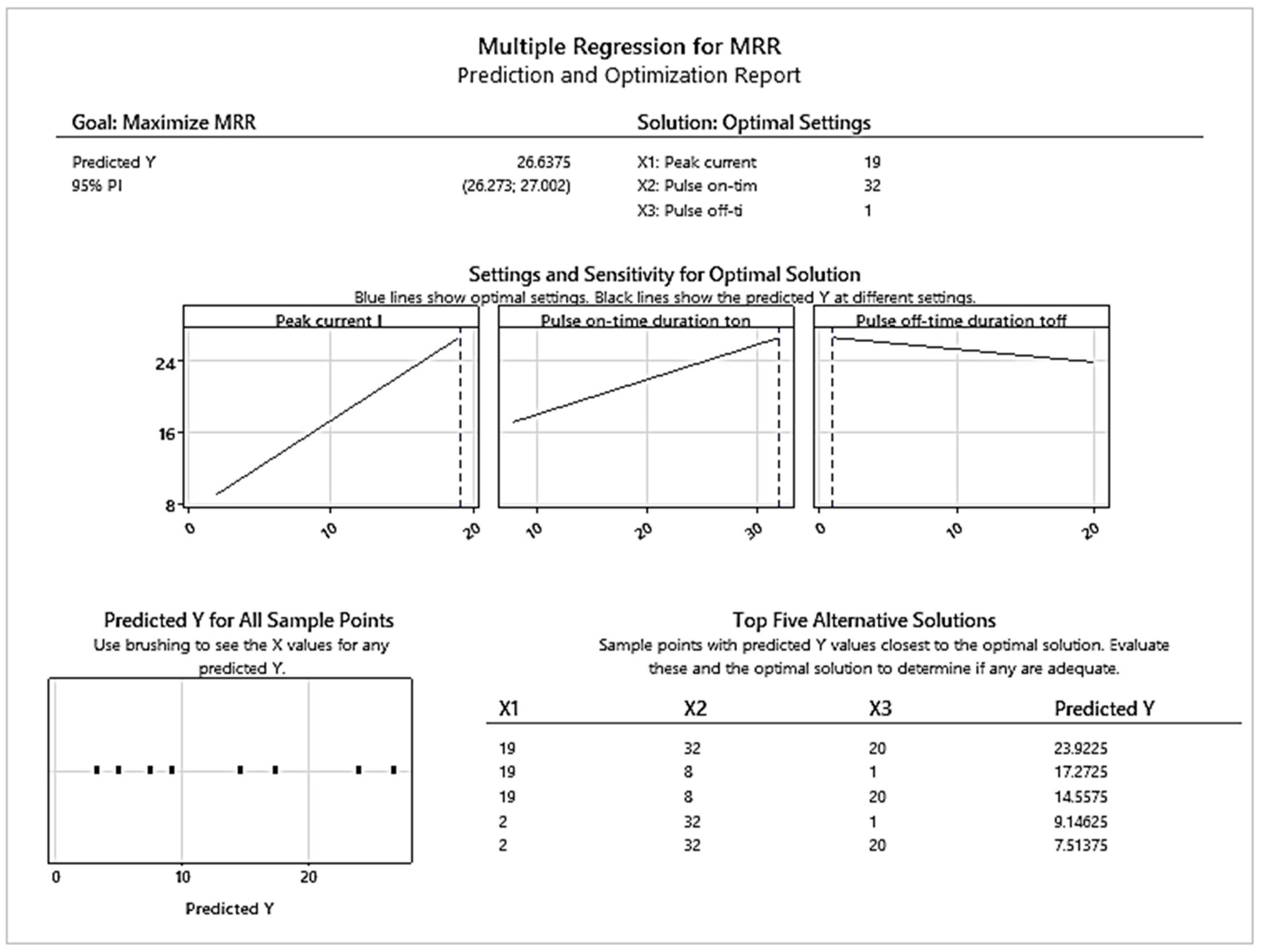
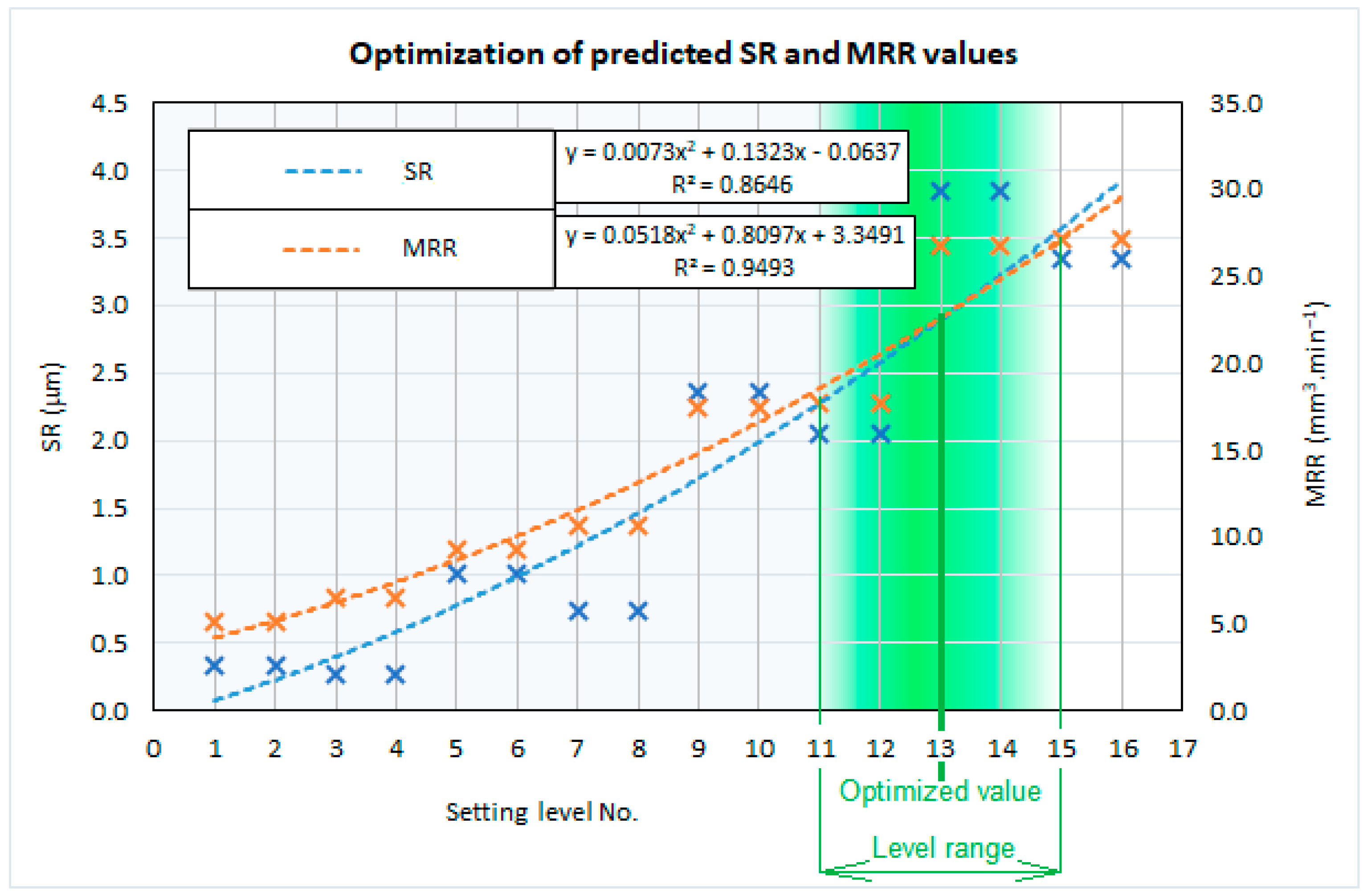
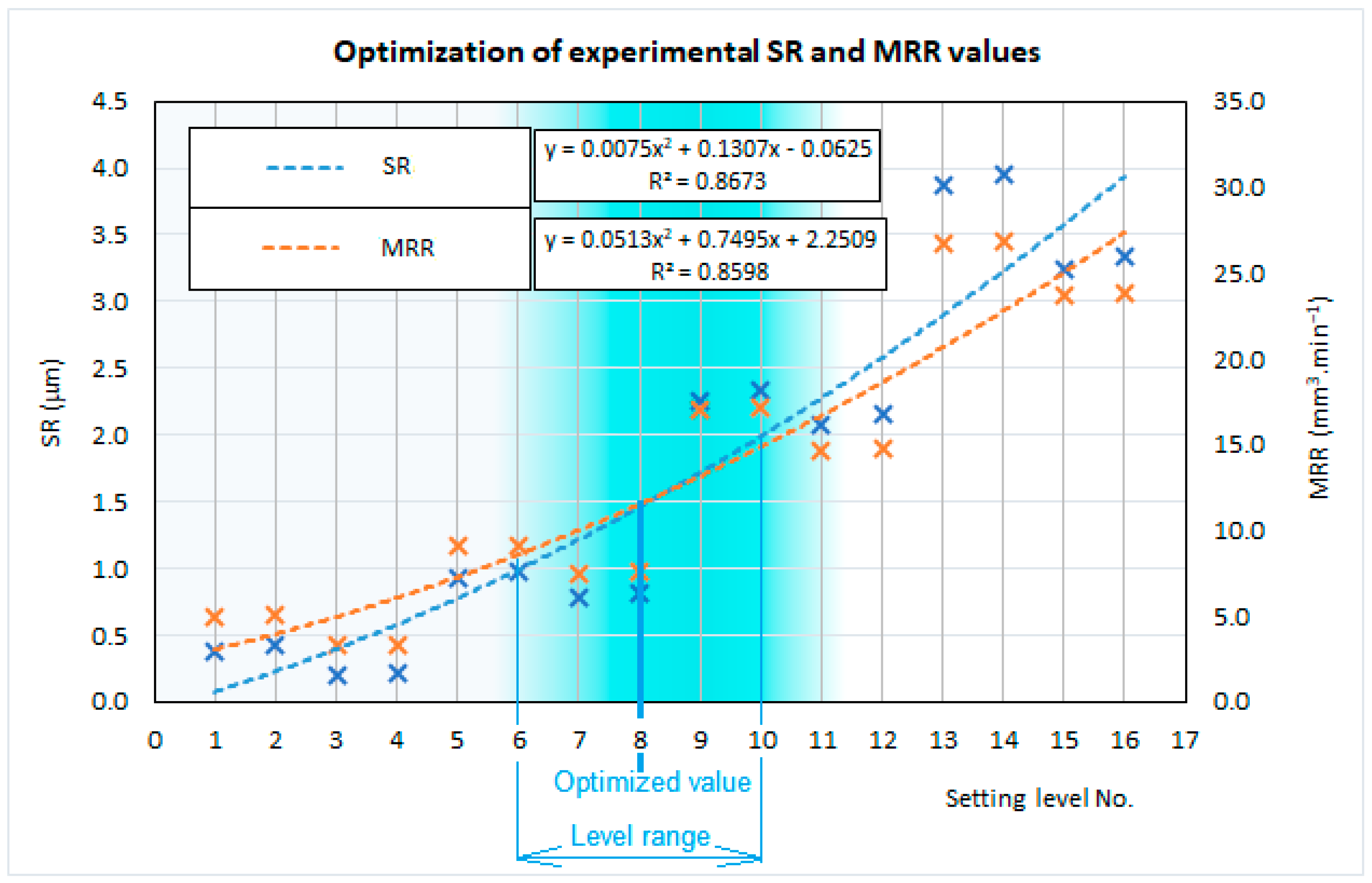
| Designation of Tool Steel | Chemical Composition of Tool Steels (wt%) | ||||||||
|---|---|---|---|---|---|---|---|---|---|
| C | Mn | Si | Cr | Mo | Ni | V | Pmax | Smax | |
| EN X37CrMoV5-1 | 0.32–0.42 | 0.20–0.50 | 0.80–1.20 | 4.50–5.50 | 1.10–1.50 | – | 0.30–0.50 | 0.03 | 0.030 |
| EN 35CrMo8 | 0.30–0.40 | 0.50–1.50 | 0.30–0.80 | 1.50–2.20 | 0.40–0.60 | – | – | 0.03 | 0.030 |
| EN X210Cr12 | 1.80–2.05 | 0.20–0.45 | 0.02–0.45 | 11.0–12.5 | – | 0.5 | – | 0.03 | 0.035 |
| Designation of Tool Steel | Basic Properties of Tool Steels | ||
|---|---|---|---|
| EN X37CrMoV5-1 | EN 35CrMo8 | EN X210Cr12 | |
| Tensile strength in natural, Rm (MPa) | 750 | 780 | 796 |
| Yield strength in natural, Rp0.2 (MPa) | 600 | 675 | 735 |
| Specific heat capacity (J·kg−1·K−1) | 460 | 460 | 460 |
| Thermal expansion coefficient at 20 °C (10−6 m·m−1·K−1) | 11.5 | 11.0 | 10.8 |
| Thermal conductivity at 20 °C (W·m−1·K−1) | 25 | 24 | 21 |
| Electrical conductivity (Siemens·m·mm−2) | 1.92 | 1.84 | 1.54 |
| Specific electric resist. (Ω·mm2·m−1) | 0.52 | 0.57 | 0.60 |
| Density (kg·dm−3) | 7.8 | 7.9 | 7.9 |
| Hardness in the annealed state HBmax | 225 | 240 | 250 |
| Achievable hardness after refining HRC | 56 | 58 | 64 |
| Parameter | Value |
|---|---|
| Portal X/Y/Z | 350 × 250 × 250 mm |
| Workpiece size X/Y/Z | 820 × 680 × 245 mm |
| Workpiece weight | 400 kg |
| Wire diameter range | 0.10–0.30 |
| Angle and bevel height | ±30°/38 mm |
| Wire feed rate | 3000 mm·min−1 |
| Dielectric volume | max. 760 L |
| Rated power | 9 kW |
| Machine weight | 2525 kg |
| MTP | Setting Range | |
|---|---|---|
| LV | HV | |
| Peak current I (A) | 2 | 19 |
| Pulse on-time duration ton (μs) | 8 | 32 |
| Pulse off-time duration toff (μs) | 1 | 20 |
| Voltage of discharge U (V) | 70 | 90 |
| Level | MTP | Experimental Results | ||||||||||||
|---|---|---|---|---|---|---|---|---|---|---|---|---|---|---|
| I (I) | ton (μs) | toff (μs) | U (V) | SR (μm) | MRR (mm3·min−1) | |||||||||
| Tool Steel No.1 | Tool Steel No.2 | Tool Steel No.3 | Standard Deviation | Average Value | Tool Steel No.1 | Tool Steel No.2 | Tool Steel No.3 | Standard Deviation | Average Value | |||||
| L1 | 2 | 8 | 1 | 70 | 0.41 | 0.36 | 0.35 | 0.03 | 0.37 | 4.99 | 4.93 | 4.91 | 0.03 | 4.94 |
| L2 | 2 | 8 | 1 | 90 | 0.46 | 0.40 | 0.38 | 0.03 | 0.41 | 5.06 | 5.01 | 4.98 | 0.03 | 5.02 |
| L3 | 2 | 8 | 20 | 70 | 0.22 | 0.19 | 0.18 | 0.02 | 0.20 | 3.29 | 3.24 | 3.21 | 0.03 | 3.25 |
| L4 | 2 | 8 | 20 | 90 | 0.24 | 0.21 | 0.20 | 0.02 | 0.22 | 3.35 | 3.29 | 3.27 | 0.03 | 3.30 |
| L5 | 2 | 32 | 1 | 70 | 0.96 | 0.94 | 0.90 | 0.02 | 0.93 | 9.12 | 9.06 | 9.04 | 0.03 | 9.07 |
| L6 | 2 | 32 | 1 | 90 | 1.03 | 0.99 | 0.93 | 0.04 | 0.98 | 9.17 | 9.13 | 9.11 | 0.02 | 9.14 |
| L7 | 2 | 32 | 20 | 70 | 0.84 | 0.74 | 0.72 | 0.05 | 0.77 | 7.56 | 7.53 | 7.48 | 0.03 | 7.52 |
| L8 | 2 | 32 | 20 | 90 | 0.87 | 0.83 | 0.77 | 0.04 | 0.82 | 7.63 | 7.59 | 7.53 | 0.04 | 7.58 |
| L9 | 19 | 8 | 1 | 70 | 2.29 | 2.25 | 2.23 | 0.02 | 2.26 | 17.11 | 17.09 | 17.03 | 0.03 | 17.08 |
| L10 | 19 | 8 | 1 | 90 | 2.37 | 2.35 | 2.29 | 0.03 | 2.34 | 17.24 | 17.18 | 17.14 | 0.04 | 17.19 |
| L11 | 19 | 8 | 20 | 70 | 2.11 | 2.06 | 2.03 | 0.03 | 2.07 | 14.73 | 14.69 | 14.61 | 0.05 | 14.68 |
| L12 | 19 | 8 | 20 | 90 | 2.22 | 2.19 | 2.10 | 0.05 | 2.17 | 14.79 | 14.74 | 14.67 | 0.05 | 14.73 |
| L13 | 19 | 32 | 1 | 70 | 3.93 | 3.84 | 3.81 | 0.05 | 3.86 | 26.81 | 26.79 | 26.69 | 0.05 | 26.76 |
| L14 | 19 | 32 | 1 | 90 | 3.98 | 3.96 | 3.92 | 0.02 | 3.95 | 26.87 | 26.82 | 26.75 | 0.05 | 26.81 |
| L15 | 19 | 32 | 20 | 70 | 3.32 | 3.25 | 3.16 | 0.07 | 3.24 | 23.79 | 23.72 | 23.69 | 0.04 | 23.73 |
| L16 | 19 | 32 | 20 | 90 | 3.37 | 3.34 | 3.29 | 0.03 | 3.33 | 23.86 | 23.80 | 23.78 | 0.03 | 23.81 |
| Run No. | SR (μm) | MRR (mm3·min−1) |
|---|---|---|
| Smaller is Better (SB) | Higher is Better (HB) | |
| Ideal sequence | 1 | 1 |
| L1 | 0.37 | 4.94 |
| L2 | 0.41 | 5.02 |
| L3 | 0.20 | 3.25 |
| L4 | 0.22 | 3.30 |
| L5 | 0.93 | 9.07 |
| L6 | 0.98 | 9.14 |
| L7 | 0.77 | 7.52 |
| L8 | 0.82 | 7.58 |
| L9 | 2.26 | 17.08 |
| L10 | 2.34 | 17.19 |
| L11 | 2.07 | 14.68 |
| L12 | 2.17 | 14.73 |
| L13 | 3.86 | 26.76 |
| L14 | 3.95 | 26.81 |
| L15 | 3.24 | 23.73 |
| L16 | 3.33 | 23.81 |
| Run No. | Evaluation of ∆0i | GRC | GRG | Rank | ||
|---|---|---|---|---|---|---|
| SR | MRR | SR | MRR | |||
| Ideal Sequence | 1 | 1 | ||||
| L1 | 0.952 | 0.072 | 0.912409 | 0.350178 | 0.631294 | 5 |
| L2 | 0.941 | 0.075 | 0.894988 | 0.350909 | 0.622948 | 6 |
| L3 | 1.000 | 0.000 | 1.000000 | 0.333333 | 0.666667 | 1 |
| L4 | 0.995 | 0.003 | 0.989446 | 0.333900 | 0.661673 | 4 |
| L5 | 0.805 | 0.247 | 0.719770 | 0.399187 | 0.559478 | 11 |
| L6 | 0.792 | 0.250 | 0.706215 | 0.400000 | 0.553107 | 12 |
| L7 | 0.845 | 0.181 | 0.763747 | 0.379144 | 0.571446 | 9 |
| L8 | 0.835 | 0.184 | 0.751503 | 0.379877 | 0.565690 | 10 |
| L9 | 0.451 | 0.587 | 0.476493 | 0.547398 | 0.511945 | 13 |
| L10 | 0.432 | 0.592 | 0.468165 | 0.550467 | 0.509316 | 14 |
| L11 | 0.501 | 0.485 | 0.500668 | 0.492475 | 0.496571 | 15 |
| L12 | 0.477 | 0.487 | 0.488918 | 0.493713 | 0.491316 | 16 |
| L13 | 0.021 | 0.997 | 0.338142 | 0.994932 | 0.666537 | 3 |
| L14 | 0.000 | 1.000 | 0.333333 | 1.000001 | 0.666667 | 1 |
| L15 | 0.189 | 0.870 | 0.381485 | 0.793266 | 0.587376 | 7 |
| L16 | 0.165 | 0.873 | 0.374625 | 0.797563 | 0.586094 | 8 |
| Factors | SR | MRR | ||||||
|---|---|---|---|---|---|---|---|---|
| Mean GRG | Max − Min | Rank | Mean GRG | Max − Min | Rank | |||
| Level 1 | Level 2 | Level 1 | Level 2 | |||||
| I | 0.84226 | 0.42023 | 0.42203 | 1 | 0.36582 | 0.70873 | 0.34291 | 1 |
| ton | 0.71639 | 0.54610 | 0.17028 | 2 | 0.43155 | 0.64300 | 0.21145 | 2 |
| toff | 0.60619 | 0.65630 | 0.05011 | 3 | 0.57413 | 0.50041 | 0.07372 | 3 |
| U | 0.63659 | 0.62590 | 0.01069 | 4 | 0.53624 | 0.53830 | 0.00206 | 4 |
| Average | 0.63124 | 0.53727 | ||||||
| Sum | 0.65311 | 0.63015 | ||||||
| Weight | 0.50895 | 0.49105 | ||||||
| Source | DF | Adj SS | Adj MS | F-Value | p-Value | Remarks |
|---|---|---|---|---|---|---|
| I | 1 | 0.006260 | 0.006260 | 1.36 | 0.0269 | Significant |
| ton | 1 | 0.001695 | 0.001695 | 0.37 | 0.0457 | Significant |
| toff | 1 | 0.000558 | 0.000558 | 0.12 | 0.0495 | Significant |
| U | 1 | 0.000074 | 0.000074 | 0.12 | 0.0901 | Insignificant |
| Error | 11 | 0.050746 | 0.004613 | |||
| Total | 15 | 0.059332 |
| Setting Level | SR (μm) | MRR (mm3·min−1) | GRG | Improvement in GRG | ||
|---|---|---|---|---|---|---|
| Initial controllabe parameters | I1-ton1-toff1-U1 | 0.38 | 4.95 | 0.63129 | ||
| I2-ton2-toff2-U2 | 0.33 | 23.82 | 0.58609 | |||
| Optimal controllabe parameters | Prediction | I1-ton1-toff2-U1 | 0.20 | 3.25 | 0.66667 | 0.03541 |
| I2-ton2-toff1-U2 | 3.95 | 26.75 | 0.66667 | 0.08058 | ||
| Experiment | I1-ton1-toff2-U1 | 0.18 | 3.52 | 0.69751 | 0.06622 | |
| I2-ton2-toff1-U2 | 3.84 | 26.41 | 0.69751 | 0.11142 | ||
| Deviation of values | 2.8% | 1.6% | ||||
Disclaimer/Publisher’s Note: The statements, opinions and data contained in all publications are solely those of the individual author(s) and contributor(s) and not of MDPI and/or the editor(s). MDPI and/or the editor(s) disclaim responsibility for any injury to people or property resulting from any ideas, methods, instructions or products referred to in the content. |
© 2024 by the authors. Licensee MDPI, Basel, Switzerland. This article is an open access article distributed under the terms and conditions of the Creative Commons Attribution (CC BY) license (https://creativecommons.org/licenses/by/4.0/).
Share and Cite
Straka, Ľ.; Čorný, I. Prediction and Multiparametric Optimization of the Machined Surface Quality of Tool Steels in Precise Wire Electrical Discharge Machining. Machines 2024, 12, 248. https://doi.org/10.3390/machines12040248
Straka Ľ, Čorný I. Prediction and Multiparametric Optimization of the Machined Surface Quality of Tool Steels in Precise Wire Electrical Discharge Machining. Machines. 2024; 12(4):248. https://doi.org/10.3390/machines12040248
Chicago/Turabian StyleStraka, Ľuboslav, and Ivan Čorný. 2024. "Prediction and Multiparametric Optimization of the Machined Surface Quality of Tool Steels in Precise Wire Electrical Discharge Machining" Machines 12, no. 4: 248. https://doi.org/10.3390/machines12040248





